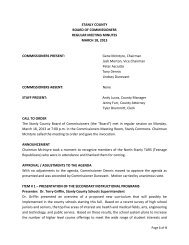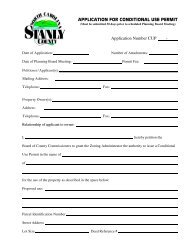Land Use Plan – 2002 - Stanly County, North Carolina
Land Use Plan – 2002 - Stanly County, North Carolina
Land Use Plan – 2002 - Stanly County, North Carolina
Create successful ePaper yourself
Turn your PDF publications into a flip-book with our unique Google optimized e-Paper software.
Conclusions<br />
STANLY COUNTY<br />
It is extremely important to note that this proposal more than likely lies outside of the 20-year<br />
framework around which long-range recommendations contained in the <strong>Stanly</strong> <strong>County</strong> <strong>Land</strong> <strong>Use</strong><br />
<strong>Plan</strong> will eventually be focused. Generally, plans for a Charlotte light rail system are focusing<br />
first on a north-south line generally following the Interstate 77 corridor with potential for<br />
expansion to the growing areas of Union and Cabarrus Counties. Regardless, should passenger<br />
rail service prove to be a desirable public improvement for the county, this important corridor will<br />
need to be preserved to maintain the capability to link to the Charlotte light rail system in the<br />
long range.<br />
<strong>Stanly</strong> <strong>County</strong>’s transportation systems have played a key role in its historical development. This<br />
same system will also define the future of <strong>Stanly</strong> <strong>County</strong> by focusing transportation<br />
improvements and enhancements to transportation corridors in growing areas of the community.<br />
Presently access to the remainder of the central <strong>North</strong> <strong>Carolina</strong> region is poor. A number of<br />
significant transportation improvements are planned for <strong>Stanly</strong> <strong>County</strong> that will remedy this<br />
situation and impact the county’s future. These projects include the widening of NC 24/27 from<br />
the western county line to Albemarle in 2005 and from Albemarle eastward by 2007. Other major<br />
improvements are planned for the U.S. 52 and NC 49 corridors. Collectively these projects will<br />
greatly improve internal countywide transportation mobility and access to adjoining areas of the<br />
central <strong>North</strong> <strong>Carolina</strong> region.<br />
<strong>Stanly</strong> <strong>County</strong>’s transportation issues do no end at its borders. Presently the eastern end of<br />
Interstate 485 is being extended northward from its present terminus at Lawyers Road in Union<br />
<strong>County</strong> to Cabarrus <strong>County</strong>. This improvement will bring Interstate 485 to within 13 miles of the<br />
county line on the NC 24/27 corridor. Other improvements will improve access to the north and<br />
south as well.<br />
Together these internal and external transportation projects will place <strong>Stanly</strong> <strong>County</strong> closer to<br />
the juncture of regional growth from the Charlotte metropolitan region. As the completion of<br />
these nears in the second-half of this decade, <strong>Stanly</strong> <strong>County</strong> and its communities will need to be<br />
ready to address the growth pressures that will come with these improvements.<br />
Utilities Analysis<br />
Water<br />
As with transportation infrastructure, the provision of utility service determines to a large extent<br />
where the future growth of <strong>Stanly</strong> <strong>County</strong> will occur. The expansion of public utilities, especially<br />
water and sewer systems, contributes significantly in predicting how and where the county will<br />
develop. This portion of Section 4 will examine public utilities—water, sanitary sewers, electricity,<br />
and natural gas systems—serving <strong>Stanly</strong> <strong>County</strong>. Public utilities and services are analyzed for<br />
the <strong>County</strong> including existing areas being served, treatment capacities, along with current<br />
demand.<br />
<strong>Stanly</strong> <strong>County</strong> residents receive water service from public water or private wells. The analysis<br />
contained in this section of the report focuses on public utility systems serving primarily<br />
unincorporated areas of <strong>Stanly</strong> <strong>County</strong>. Figure 4-5 illustrates existing water lines serving the<br />
county.<br />
<strong>Stanly</strong> <strong>County</strong> obtains its water from the City of Albemarle. The county has 16 years left on a 40year<br />
contract with the City of Albemarle for the provision of 3 million gallons per day (mgd) of<br />
water. Presently the county only uses around 1.5 mgd. As a result, the county has a large<br />
potential for expanding its current system. Water is provided by the <strong>Stanly</strong> <strong>County</strong> Utilities<br />
Department to unincorporated areas as well as the Towns of Locust and Stanfield. <strong>Stanly</strong><br />
<strong>County</strong> also owns, and operates the water system for the Town of Badin through the Greater<br />
<strong>Land</strong> <strong>Use</strong> <strong>Plan</strong> 4-11 6/02






